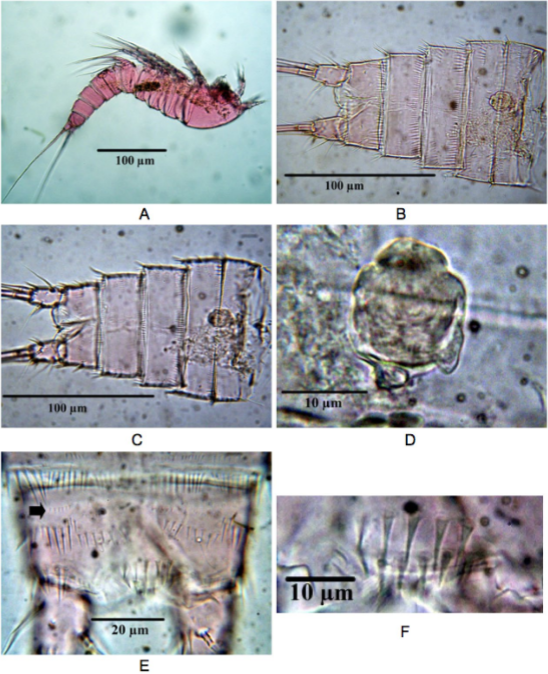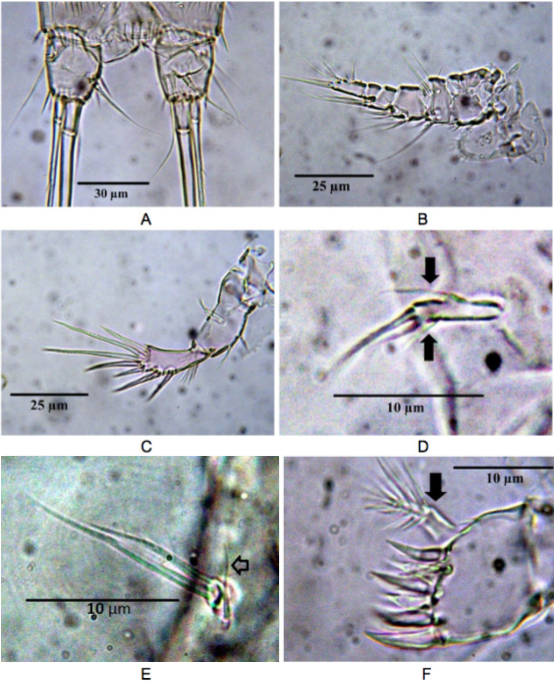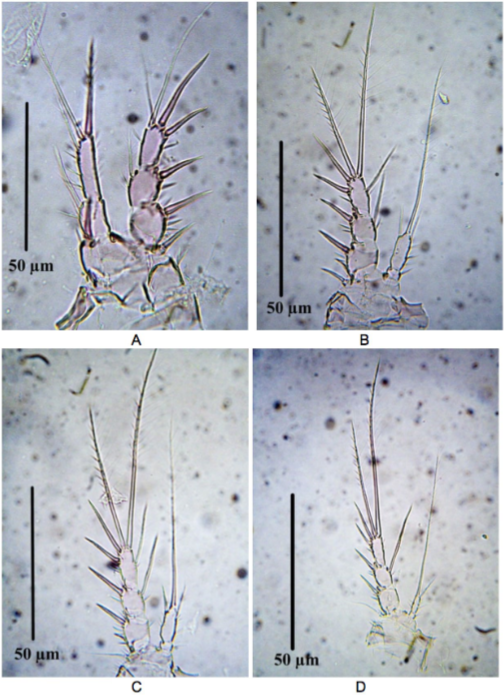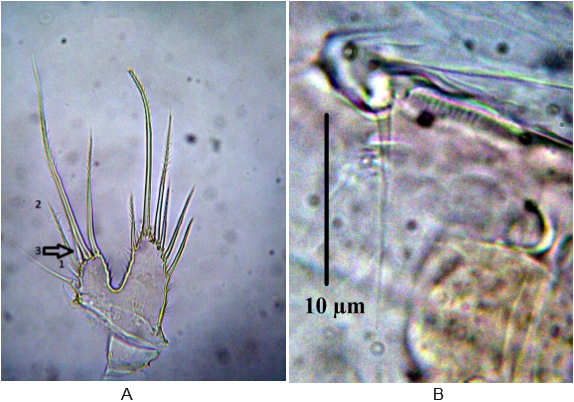INTRODUCTION
The systematic position of the genus Cletocamptus Schmankewitsch, 1875 (Harpacticoida: Canthocamptidae Brady, 1880) is still controversial. Species of Cletocamptus can be found in estuaries and coastal lagoons, as well as in freshwater habitats (GÓMEZ et al., 2004, 2007; BOXSHALL & DEFAYE 2008), and hypersaline situations (GÓMEZ et al., 2004; SUÁREZ-MORALES et al., 2013), and the genus shows a wide distribution. Most species have been recorded at low altitude (0 - 600 m a.s.l.) e.g., C. nudusGómez, 2005, C. sinaloensis Gómez, Fleeger, Rocha-Olivares & Foltz, 2004, C. samariensis Fuentes-Reinés, Zoppi de Roa & Torres, 2015 (GÓMEZ et al., 2005; FUENTES-REINÉS et al., 2015), but some of them are also known to inhabit high altitude localities (e.g., C. cecsurirensis Gómez, Scheihing & Labarca, 2007 from Salar de Surire, Chilean high Andean Plateau at 2265 m a.s.l (GÓMEZ et al., 2007), and C. gomezi Suárez-Morales, Barrera-Moreno & Ciros-Pérez, 2013 from Lake Alchichica at 4180 m a.s.l.) (SUÁREZ-MORALES et al., 2013).
Following FUENTES-REINÉS et al. (2015) and GÓMEZ et al. (2017), there are 29 valid species of Cletocamptus. Of these, 19 have been recorded in America. Species of Cletocamptus from America have been found in Argentina, Brazil, Chile, Colombia, Mexico and the United States (FLEEGER, 1980; MIELKE, 2000; GÓMEZ, 2005; GÓMEZ & GEE, 2009; FUENTES-REINÉS & SUÁREZ-MORALES, 2014; GÓMEZ & MORALES-SERNA, 2014; FUENTES-REINÉS et al., 2015; GÓMEZ et al., 2017). The knowledge about the presence of this genus in Colombia is still very limited; up to now, only four species: C. dominicanusKiefer 1934, C. helobiusFleeger, 1980, C. nudusGómez 2005, and C. samariensis Fuentes-Reinés, Zoppi de Roa & Torres, 2015, have been reported from three Caribbean localities of Colombia (Pozos Colorados in Santa Marta, Magdalena, Laguna Navío Quebrado, La Guajira, and in a temporal pond in Puebloviejo, Magdalena) (FUENTES-REINÉS & SUÁREZ-MORALES, 2014; FUENTES-REINÉS et al., 2015, GÓMEZ et al., 2017). The copepod fauna from Colombia has received little attention despite the number of fresh, marine and brackish systems in both the Atlantic and Pacific coasts of the country and additional new species and records of harpacticoids are expected to be found in future studies.
Here we present the first record of C. sinaloensis in northern Colombia (Magdalena department), and Caribbean Sea which expands the regional distributional range of this copepod in northern South America. The aim of this paper is to report the first record of C. sinaloensis for Colombia and to present a brief description of this material in order to support the identification of the newly found material.
MATERIALS AND METHODS
Water samples were taken at Cienaga Grande de Santa Marta Colombia (10°52’11.25” N and 74°19’31.64” W) in April of 2015. Water salinity was measured with a WTW 3111 conductivity meter. Water sam ples were collected using a 25 L bucket. Samples were filtered with a standard zoo plankton net (45 μm mesh size) and fixed and preserved in 70% ethanol. Harpacticoid copepods were separated from the sediment with a brush. Dissected specimens and appendages were mounted in glycerine. The dissected appendages were photographed using a Kodak Easy Share C140 digital camera adapted to a compound microscope at a magnification of 1000X. Identification of this species of Cletocamptus followed the keys and descriptions by GÓMEZ et al. (2004); GOMEZ (2005), WELLS (2007) and GÓMEZ & GEE (2009). The specimens were measured in lateral position, from the anterior end of the rostral area to the posterior margin of the caudal rami. Mor phological nomenclature follows HUYS & BOXSHALL (1991). The following abbreviations are used in the descriptions: P1-P6, first to sixth swimming legs; EXP, exopod; ENP, endopod. The specimens were deposited in the collection held at the Museo de Colecciones Biológicas from Universidad del Atlántico, (UARC), Barraquilla- Atlántico, Colombia.
RESULTS
Order HARPACTICOIDA G.O. Sars, 1903
Family CANTHOCAMPTIDAE Brady, 1880
Genus CletocamptusSchmankevitsch, 1875
Cletocamptus sinaloensisGómez, Fleeger, Rocha-Olivares & Foltz, 2004 (Figs. 1-3)
Material examined: 2 adult females (UARC329M).
Description of female
The studied specimens (2 adult females) agree with the descriptions and illustrations by GÓMEZ et al. (2004) and GÓMEZ (2005). Body length of the Colombian females ranged between 630 µm to700 µm (n = 2). Body shape (Fig. 1A) as for the genus. Ventral and dorsal surface of urosomites ornamented with transverse rows of spinules as illustrated (Figures 1B-C). Seminal receptacle as in figure 1D. Dorsal surface of anal somite (Figure 1E) ornamented with proximal transverse rows of minute spinules (arrowed in figure 1E) and transverse rows of stronger spinules. Anal operculum with two rows of strong spinules (Figure 1F). Caudal rami about 1.3 times as long as wide (Figure 2A), with seven elements.

Figure 1 Cletocamptus sinaloensis. Female from Ciénaga Grande de Santa Marta Colombia. A: Habitus. B. Urosoma, ventral view. C. Idem, dorsal view. D. Seminal receptacle. E. Anal somite, dorsal view. F. Anal operculum.
Antennule (Figure 2B) with six segments.
Antenna (Figure 2C) with small coxa. Allobasis armed with two abexopodal setae. Free endopodal segment with inner strong spinules proximally and subdistally, with two lateral inner spines and five distal elements. Exopod one-segmented, with one lateral small and one apical long seta, and two spinules in each side (arrowed in Figure 2D).
Mandibular palp (Figure 2E). represented by 1 small segment bearing 2 naked setae, accompanied by 1 slender seta nearby (arrowed in figure 2E).
Arthrite of praecoxa of the maxillule (Figure 2F), armed with seven distal spines and one lateral strong seta, the latter ornamented with long spinules (arrowed in Figure 2F).

Figure 2 Cletocamptus sinaloensis. Female from Ciénaga Grande de Santa Marta Colombia. A. Caudal rami, dorsal view. B. Antennule. C. Antenna. D. Antenal exopod. E. Mandibular palp. F. Maxillule.
P1-P4 EXP three-segmented, distal segments with 4, 5, 5, 4 setae/spines, respectively. ENP two-segmented; P1-P4 ENP2 with 3, 3, 3, 2, setae, respectively (Figures 3A-D). Inner seta of P1ENP1, P2EXP2-3; P3EXP2-3, and P4EXP2 with a brush tip.

Figure 3 Cletocamptus sinaloensis. Female from Ciénaga Grande de Santa Marta Colombia. A. P1. B. P2. C. P3. D. P4.
P5 (Figure 4A). Exopod and baseoendopod fused. Endopodal lobe 1.6 times as long as exopod, armed with six elements. Exopodal lobe armed with five elements, plus outer basal element.
P6 vestigial, represented by median plate in anterior half of second urosomite (first genital somite) with a long seta (Figure 4B).
Distribution and ecology
Cletocamptus was originally described from Mexico (GÓMEZ et al., 2004), but is also known from Brazil (GÓMEZ, 2005). In Colombia this species was found in Ciénaga Grande de Santa Marta, Magdalena, on the Caribbean coast of Colombia, and represents a range extension of the species to the Guajira province sensuMORRONE (2014) in the Caribbean coast of Colombia. Ciénaga Grande de Santa Marta is a shallow swamp (depth 0.5-1.5m), with following water chemistry at the date: 31.2° C, pH = 8.9, salinity = 15 PSU, dissolved oxygen = 7.86 mg/L.
DISCUSSION
The specimens of Cletocamptus sinaloensis examined (two adult females) agree with the descriptions and illustrations by GÓMEZ et al. (2004) and GÓMEZ (2005). This species can be easily recognized by a unique combination of characters including: 1) antennal exopod one-segmented with two setae, 2) mandibular palp with three elements, 3) arthrite of maxillule with a strong and spinulose lateral seta , 4) female P2-P4 EXP3 and ENP2 with 5-5-4 and 3-3-2 elements respectively, 5) anal operculum with two rows of strong spinules, 6) caudal rami of about 1.3-1.5 times as long as wide, and 7) caudal setae IV and V separated, not fused. These distinctive characteristics also were observed in the specimens from Colombia.
Cletocamptus sinaloensis seems to be closely related to C. levisGómez 2005, known from Brazil. The closeness of these species was assumed based on the general shape and number of setae of the mandibular palp (one-segmented with three setae), P2-P4 EXP3 and ENP2 with 5-5-4 and 3-3-2 elements respectively, length: width ratio of the caudal rami, and ornamentation of the anal operculum (with two rows of strong spinules). Nevertheless, they can be separated by 1) the armature complement of the antennal exopod (with three setae in C. levis (GÓMEZ, 2005, fig 18B ), but with two setae in C. sinaloensis (GÓMEZ et al., 2004, fig 26B; GÓMEZ 2005, fig, 8B, present data, fig 2D), 2) length of the exopodal lobe of the female P5 (reaching insertion site of outermost baseoendopodal seta in C. levis (GÓMEZ 2005, fig 17B), but shorter in C. sinaloensis (GÓMEZ et al., 2004, fig 25B; GÓMEZ 2005, fig 7B, present paper, Figure 4A), 3) relative length of the P3ENP (barely reaching the tip of P3 EXP1 in C. levis (GÓMEZ et al., 2004, fig 20A), but reaching the middle of P3 EXP2 in C. sinalonesis (GÓMEZ et al., 2004, fig 28A; GÓMEZ 2005, fig 10A; present paper, Figure 3C), 4) number of setae on the female P6 (with two setae in C. levis, being the outer element longest (GÓMEZ 2005, fig 17A), but with one seta only in C. sinaloensis (GÓMEZ et al., 2004, fig 25A, GÓMEZ 2005, fig 7A, present paper, Figure 4B).
The specimens from Colombia are identical in most aspects to those recorded from Mexico and Brazil. Nevertheless, some subtle differences were observed: 1) the shape of seminal receptacle (circular in the Mexican and Colombian populations (GÓMEZ et al., 2004, fig 25A, present paper, Figure 1D), but oval in the Brazilian material (GÓMEZ 2005, fig 7A), 2) relative length of the seta of P6 (longer in the specimens from Colombia (present paper, Figure 4B) than the Mexican and Brazilian population (GÓMEZ et al., 2004, fig 25A; GÓMEZ, 2005, fig 7A). Overall, we do not regard such differences as evidence enough to consider our specimens as representatives of a new species.
Key for the identification of the nominal species of Cletocamptus recorded in Colombia
1A. P1 ENP1 without inner seta, P4 ENP represented by a single seta, female P5 EXP and ENP with 5 and 3 setae respectively, male P5 EXP and ENP with 3 and 3 setae respectively… C. helobius* Fleeger, 1980 *This record from Colombia should be revised; it might represent a new species (Gómez et al., 2017)
1B. P1 ENP with inner seta, P4 ENP one- or two-segmented...2A
2A. P4 ENP two-segmented, P3 ENP2 with 3 setae, antennal exopod elongate, onesegmented with 2 setae... 3A
2B. P4 ENP one segmented, P3 ENP2 with 5 setae, antennal exopod minute, one-segmented, with 1 seta, caudal rami about 2 times as long as wide, male and female P5 EXP and ENP separated by a small notch, male P5EXP with 4 setae… C. dominicanusKiefer, 1934
3A. P3-P4 EXP3 with 5-4 elements respectively, anal operculum with 2 rows of strong spinules, caudal rami about 1.3-1.5 time as long as wide, female P6 with 1 seta, male and female P5 EXP and ENP separated by a deep notch, male P5 EXP with 4 setae... C. sinaloensisGómez, Fleeger, Rocha-Olivares & Foltz, 2004
3B. P3-P4 EXP3 with 6-5 elements respectively, distal row of spinules on anal operculum absent or present, caudal rami about 1.5 times as long as wide, female P6 with 2 setae, male and female P5 EXP and ENP separated by deep notch, female P5 EXP with 4 or 5 setae, male P5 EXP with 3 or 4 setae… 4A
4A. Distal row of spinules on anal operculum present, female P5 EXP with 4 setae, male P5 EXP with 3 setae... C. samariensis Fuentes-Reinés, Zoppi de Roa & Torres, 2015
4B. Anal operculum bare, female P5 EXP with 5 setae, male P5 EXP with 4 setae… C. nudusGómez, 2005.















